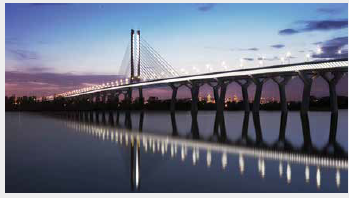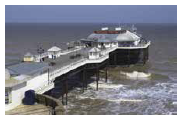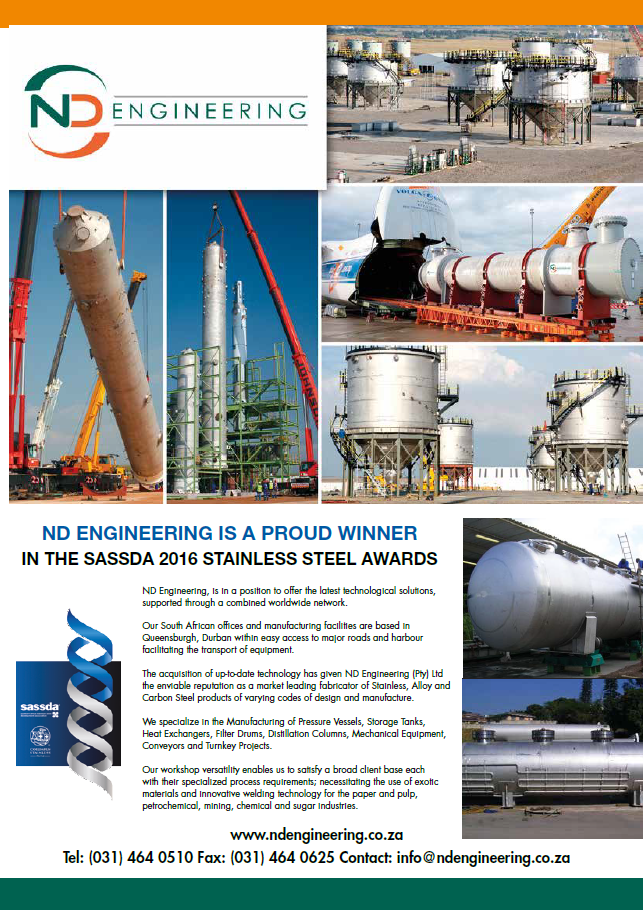The need for structures – typically bridges and piers – that last one hundred years or more, with little or no maintenance, rather than the much shorter design life incurred with the use of other materials, are clearly a consideration in the planning of key projects across the country. Against this backdrop, stainless steel reinforcing bar (rebar) in concrete needs to be recognised as a far more reliable way to resist corrosion and provide a superior service life (100 years) and life cycle costing figures.
WHY DOES REBAR CORRODE?
Premature deterioration of reinforced concrete structures has become a serious problem worldwide due to corrosion of the embedded steel.
The estimated annual cost of corrosion in the USA for bridges alone exceeds $8 billion. The structures chiefly affected are those situated in aggressive environments such as marine and road bridges to which de-icing salts are applied during winter periods.
CHAMPLAIN BRIDGE, CANADA

Stainless steel rebar has been chosen as the material of choice for the new Champlain Bridge in Montreal, Canada. The actual Champlain bridge over the St Lawrence River conveys about some 57millions vehicles per year, the highest traffic for a bridge in Canada. At peak hours, up to 6200 vehicles cross the bridge in a single direction. The bridge is not only remarkable by its length, 3,4 km, but also because its features a sufficient clearance over the seaway to allow the passage of sea-going vessels to and from the Great Lakes.
Commissioned in 1962, the existing bridge is now obsolete. The deck and the concrete have been badly damaged by corrosion mainly caused by de-cing salts over the years, while the traffic is now much higher than what the bridge was designed for. Maintenance is more and more expensive just to keep it in service The new bridge will be built of reinforced concrete. New features include higher traffic capacity, lanes for public transportation vehicles (such as a light rail service), larger clearances for ships above the seaway and an elegant design.
Approximately 15 000 tonnes of 2304 duplex stainless steel rebar will be used to resist corrosion by de-icing salts in the critical areas.
CROMER TOWN, UNITED KINGDOM
 Cromer is an important seaside town on the North Norfolk coast. Cromer is protected from the erosive power of the North Sea through a series of coastal defences which include a seawall and timber groynes, which are periodically repaired. Following the major storm of December 2013, a large repair work has been carried out. It includes re-facing the existing sea walls with concrete, improving the parapet walls where necessary and repairing the timber groynes, at a cost of approximately £8m.
Cromer is an important seaside town on the North Norfolk coast. Cromer is protected from the erosive power of the North Sea through a series of coastal defences which include a seawall and timber groynes, which are periodically repaired. Following the major storm of December 2013, a large repair work has been carried out. It includes re-facing the existing sea walls with concrete, improving the parapet walls where necessary and repairing the timber groynes, at a cost of approximately £8m.
These repairs have been designed not only to maintain the existing level of defence, but also to withstand 50 years of predicted sea level rise. In order to achieve this objective, 335 tonnes of duplex stainless steel grade 2304 reinforcing bar were used.
ALLT CHONOGLAIS, SCOTLAND
 The existing A82 Allt Chonoglais Bridge was identified as being understrength to carry future traffic loads. Its repair and strengthening was deemed uneconomic and so in August 2012 work started to demolish and replace the existing bridge (pictured right) with a new stronger reinforced concrete structure, (pictured bottom right) incorporating both carbon steel and stainless steel rebar.
The existing A82 Allt Chonoglais Bridge was identified as being understrength to carry future traffic loads. Its repair and strengthening was deemed uneconomic and so in August 2012 work started to demolish and replace the existing bridge (pictured right) with a new stronger reinforced concrete structure, (pictured bottom right) incorporating both carbon steel and stainless steel rebar.
In order to create a durable and economic bridge over the full design life period it was decided by the consultant engineers that stainless steel rebar should be used in the areas which are at greater risk from chloride induced reinforcement corrosion due to the application of de-icing salts during the winter months.
This included the bridge deck, abutments, wing walls and bearing plinths The original specification called for EN 1.4301 (304) stainless steel rebar, but after in-depth discussions with the supplier, steel designation EN 1.4362 (2304) was accepted as an alternative. Tests show that this grade has a Critical Chloride Threshold Level (CCTL) over 4 % per mass of cement at room temperature, which is over ten times the figure usually associated with carbon steel rebar and beyond the levels normally expected at typical rebar depths of cover, concrete quality, and for a 120 year design life, even in the most severe of chloride environments. In order to avoid contamination with carbon steel, all of the stainless steel rebar was fully cut and bent to shape on machinery designed and used solely for stainless steel.
JUNCTION VÄRTAN, STOCKHOLM
A major junction in a new motorway around northern Stockholm is built using lean duplex stainless steel reinforcement bar from Outokumpu to optimize economy and maintenance-free durability – a solution for sustainability on roads.
The Swedish capital Stockholm looks to a future with less traffic in the city: traffic will soon be re-routed away from the centre to a new ring road around Stockholm, complete with an urban motorway named Norra Länken – Northern Connection. Completed in phases by 2017, Norra Länken constitutes Sweden’s largest road construction project to date.
 The new motorway, which largely runs in tunnels, connects Sweden’s main Baltic port at the Värta harbour (Värtahamnen) with the national Swedish and European road networks. Traffic flows will be joined in the major Junction Värtan at the harbour. Construction of this junction, realized with overpasses will take four years to complete and consume ten thousand truckloads of concrete alone.
The new motorway, which largely runs in tunnels, connects Sweden’s main Baltic port at the Värta harbour (Värtahamnen) with the national Swedish and European road networks. Traffic flows will be joined in the major Junction Värtan at the harbour. Construction of this junction, realized with overpasses will take four years to complete and consume ten thousand truckloads of concrete alone.
Junction Värtan should serve largely maintenance free for a very long time. To achieve this goal, the Stockholm Road Authority specified stainless steel reinforcement for the concrete structures from the very beginning of the design process, aware of the many benefits of stainless that would enable the long life span.
Roads in northern climates are particularly corrosive environments due to chlorides from de-icing salts. Stainless steel rebar are an insurance against corrosion, which could result in structural failure. As such, stainless steel rebars help to avoid expensive repairs and resulting disruption to traffic.
Outokumpu’s proprietary lean duplex stainless steel LDX 2101 has been specified as the material of choice due to its corrosion resistance and cost efficiency.
Outokumpu believes Junction Värtan is just the start of LDX 2101 rebars being used in Sweden’s infrastructure and worldwide.


